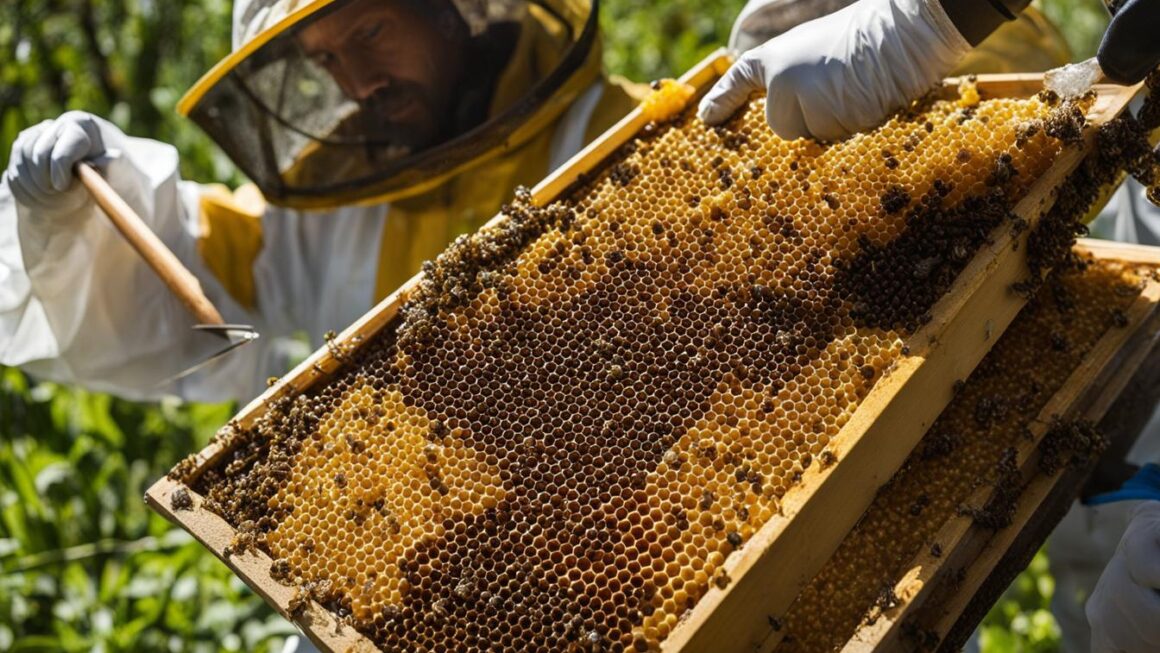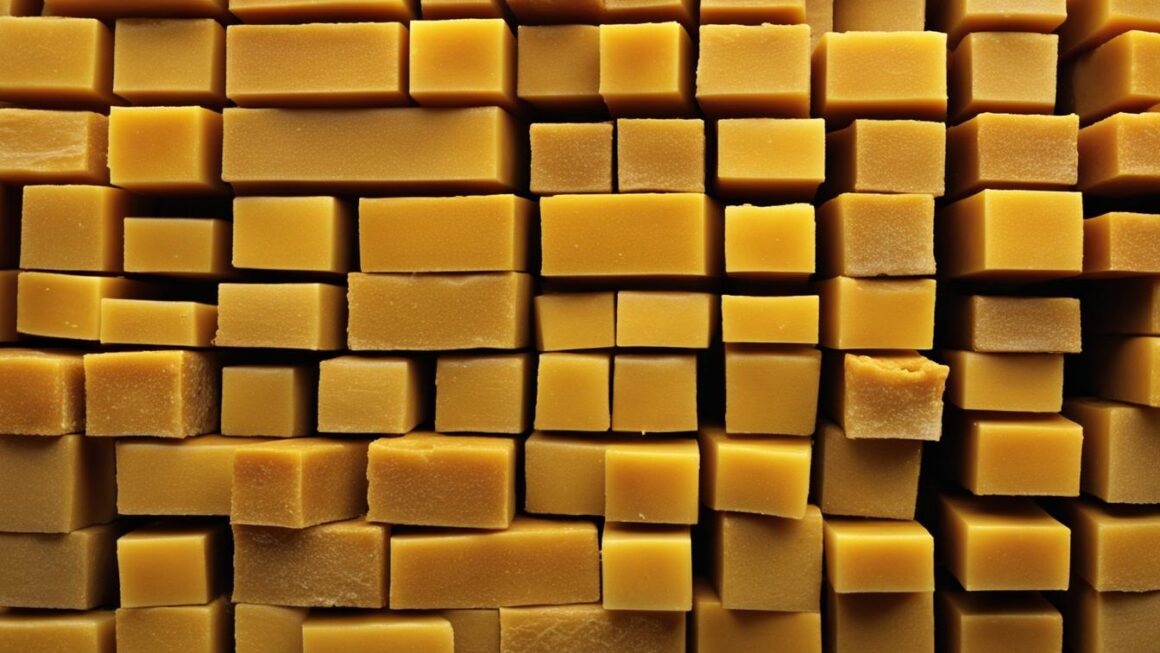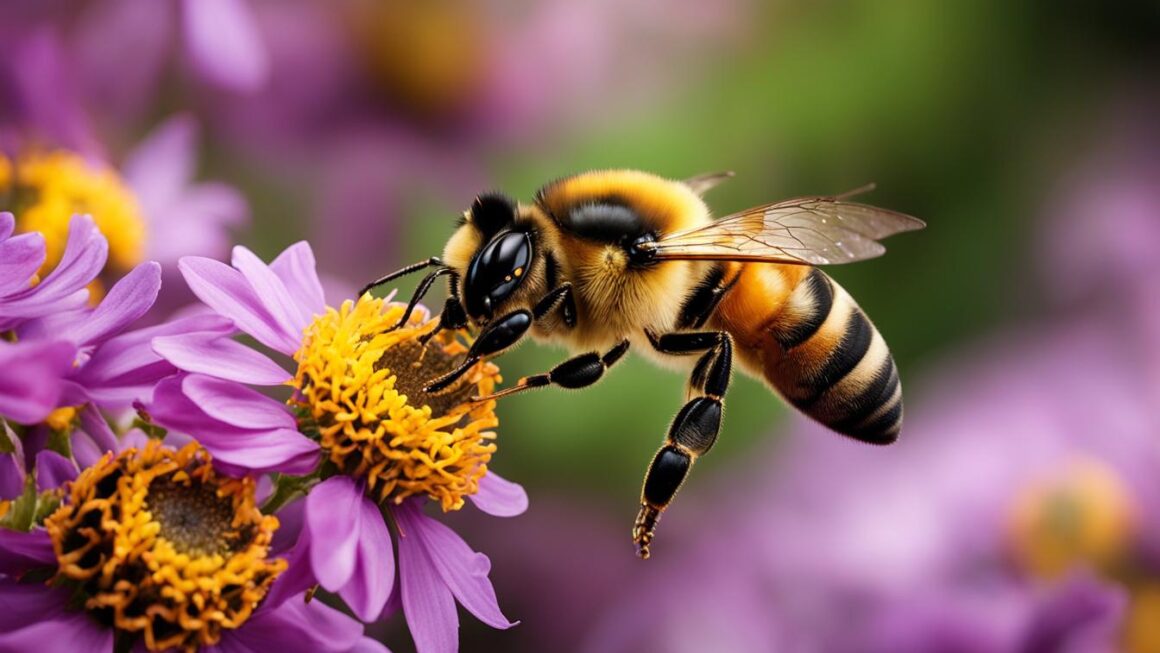Beeswax is a valuable natural resource produced by honey bees that has been used for centuries in various industries. From skincare to candle making, beeswax offers numerous benefits and has a wide range of uses. In this comprehensive guide, we will delve into the process of harvesting beeswax, explore different methods of extraction, and uncover the many uses and benefits of this versatile substance.
Whether you’re a beekeeper looking to maximize your beeswax production or someone interested in the sustainable use of natural resources, this guide will provide you with the knowledge and techniques needed to harvest beeswax effectively. Discover the fascinating world of bees and unlock the potential of this remarkable substance.
Key Takeaways:
- Beeswax is a natural resource produced by honey bees and has numerous benefits and uses.
- Harvesting beeswax involves careful extraction and processing.
- There are various methods and tools available for collecting beeswax from beehives.
- Filtered and cleaned beeswax can be stored for future use.
- Beeswax is used in skincare, candle making, and other industries due to its unique properties.
When and How to Harvest Beeswax
Harvesting beeswax requires careful timing and proper techniques to ensure a successful and safe process. Knowing the best time to harvest beeswax is crucial in maximizing the yield while minimizing disturbance to the hive. The ideal time for harvesting is when there are fewer bees around the hive, usually in the morning or late afternoon. During these times, the bees are less active, making it easier to handle the frames and extract the wax.
To ensure your safety during the harvesting process, it is essential to wear protective gear. A beekeeper’s suit, including a veil, suit, and gloves, provides necessary protection from bee stings. Wearing this gear will help minimize the risk of getting stung and allow you to handle the frames confidently.
Additionally, using a smoker can be beneficial when harvesting beeswax. The smoke from the smoker helps calm the bees by disrupting their communication, making them less aggressive and more manageable. By properly utilizing a smoker, you can create a peaceful environment for harvesting and avoid unnecessary disturbances to the hive.
Harvesting Techniques
When it comes to harvesting beeswax, there are various techniques you can employ. One common method is to remove frames with wax caps and use a hot uncapping knife to scrape off the wax. The wax caps are the protective layer bees create to seal honey cells, and by removing them, you can access the beeswax.
Using a hot uncapping knife allows for precise and efficient wax extraction. The heated knife melts through the wax caps, making it easier to remove the wax and collect it for further processing. It is important to handle the hot knife with caution and follow safety guidelines to prevent any accidents or injuries.
By understanding the best time to harvest beeswax, wearing protective gear, and utilizing the appropriate techniques, you can ensure a successful and safe beeswax harvesting process. These practices not only safeguard your well-being but also contribute to the overall health and productivity of the hive.
Tools and Equipment for Beeswax Harvesting
When it comes to harvesting beeswax, having the right tools and equipment is essential. Here are some key items that every beekeeper should have:
- Beekeeper’s outfit: This includes a veil, suit, and gloves to provide necessary protection from bee stings.
- Bee smoker: A smoker is used to calm the bees during the harvesting process, making it easier and safer.
- Hive tool: A hive tool is a multipurpose tool that helps in safely removing frames and bees from the hive.
- Bee brush: A soft-bristled bee brush is used to gently brush bees off frames and other equipment.
- Hot uncapping knife: This special knife is heated and used to scrape off the wax caps from the frames.
- Bucket: A bucket is used to collect the wax caps and other harvested beeswax.
Having these tools and equipment on hand will make the process of harvesting beeswax much more efficient and safe. They are specifically designed for beekeeping tasks and ensure that the bees and the beekeeper are protected throughout the process.
Steps for Harvesting Beeswax
Harvesting beeswax involves several essential steps to ensure a successful extraction. By following these steps, beekeepers can collect beeswax efficiently and effectively.
To begin the process, it is necessary to remove frames with wax caps from the hive. These frames are identified by the presence of a layer of wax covering the honeycomb cells. Using a hot uncapping knife, carefully scrape off the wax caps. This allows the honey to be accessed and extracted later while collecting the valuable beeswax.
Once the wax caps have been removed, it is important to collect them in a bucket. This ensures that all the wax is gathered in one place, making it easier for further processing. The wax caps can be quite sticky, so wearing gloves is recommended to prevent residue from sticking to hands and tools.
After collecting the wax caps in a bucket, the next step is rendering the wax. Rendering refers to the process of separating the beeswax from any impurities or honey that may be present. To render the wax caps, allow them to drain for a short period, and then transfer them to a small bowl. The wax can be further purified and processed according to personal preferences and specific requirements.
| Steps for Harvesting Beeswax |
|---|
| 1. Remove frames with wax caps from the hive |
| 2. Use a hot uncapping knife to scrape off wax caps |
| 3. Collect wax caps in a bucket |
| 4. Render the wax caps to separate beeswax |
Harvesting beeswax requires precision and attention to detail. By following these steps, beekeepers can successfully gather beeswax for various uses and enjoy the benefits of this natural resource.
Filtering and Cleaning Beeswax
Once beeswax has been harvested, it needs to undergo a process of filtering and cleaning to remove impurities and ensure its purity. This is an essential step to prepare the beeswax for further use in various applications. The filtering and cleaning process can be done easily with a few simple steps.
Filtering Beeswax
To filter beeswax, you will need cheesecloth, which is a loosely woven fabric that allows the liquid beeswax to pass through while capturing any debris or impurities. Start by placing the cheesecloth over a container or pot and secure it tightly. Next, melt the beeswax by placing it in a pot of hot water. Pour the melted beeswax onto the cheesecloth, allowing it to flow through and collect in the container below. The cheesecloth will act as a filter, trapping any residue or impurities, producing clean and pure beeswax.
Cleaning Beeswax
Cleaning the beeswax is another important step in the process. After filtering, the beeswax may still contain some residual debris. To clean the beeswax, you can melt it again using the double boiler method or a dedicated wax melting pot. As the wax melts, any remaining impurities will sink to the bottom while the clean beeswax floats on top. Carefully separate the clean beeswax from the debris at the bottom, ensuring only the purest wax is retained. This can be done by carefully pouring the melted wax into molds or containers, leaving behind the residue.
Remember that when handling beeswax, it is important to do so in a well-ventilated area and exercise caution as hot wax can cause burns. It is also advisable to clean the utensils used in the process thoroughly to avoid cross-contamination.
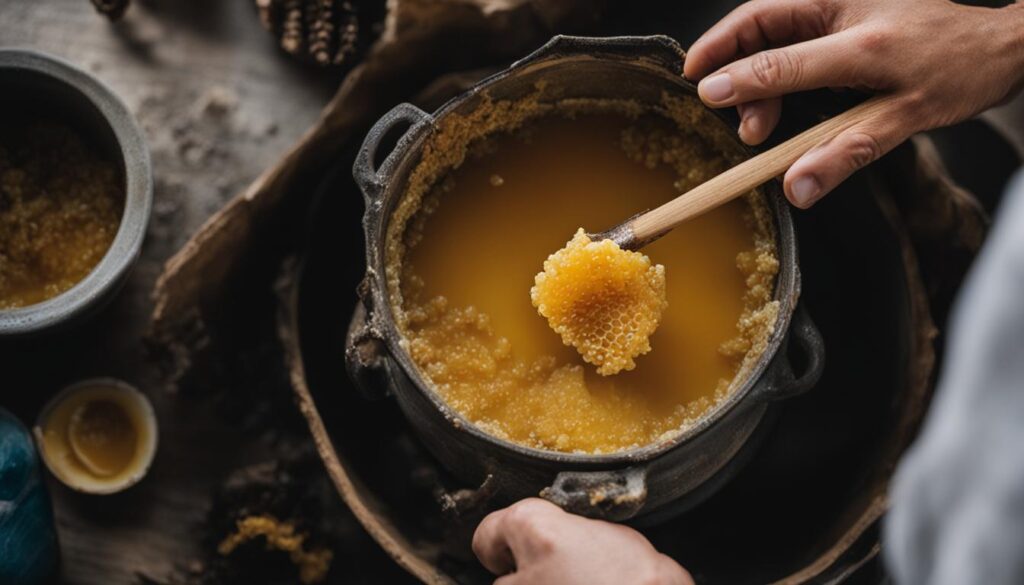
| Step | Description |
|---|---|
| Filtering | Place cheesecloth over a container, melt beeswax, and pour it onto the cheesecloth to filter out impurities. |
| Cleaning | Melt the filtered beeswax again, separate the clean wax from the debris at the bottom. |
Storing Beeswax
Proper storage of beeswax is crucial for preserving its quality and usability. Beeswax should be kept in a cool and dry place to prevent melting or deterioration. As beeswax is a natural material, it can be affected by heat and humidity, causing it to lose its shape and consistency.
To store beeswax effectively, it is recommended to use airtight containers that will protect it from dust, moisture, and other contaminants. Plastic containers or bags are commonly used for this purpose, as they provide a reliable seal and are easy to handle. It is important to label the containers with the date of harvesting to ensure the freshness of the beeswax.
Additionally, it is advised to store beeswax away from strong odors, as it has the ability to absorb scents from its surroundings. This can affect the fragrance of beeswax-based products such as candles or cosmetics if stored together with heavily scented items. By storing beeswax properly, its quality and usability can be preserved for an extended period.
| Storage Tips for Beeswax | Benefits |
|---|---|
| Store in a cool and dry place | Prevents melting and deterioration |
| Use airtight containers | Protects from dust and contaminants |
| Avoid storing with strongly scented items | Preserves natural fragrance of beeswax |
| Label containers with harvest date | Ensures freshness and traceability |
By following these storage practices, beekeepers and enthusiasts can maintain the quality of their beeswax and ensure its effectiveness in various applications. Whether it’s for crafting, skincare, or candle making, properly stored beeswax will continue to provide its many benefits for an extended period of time.
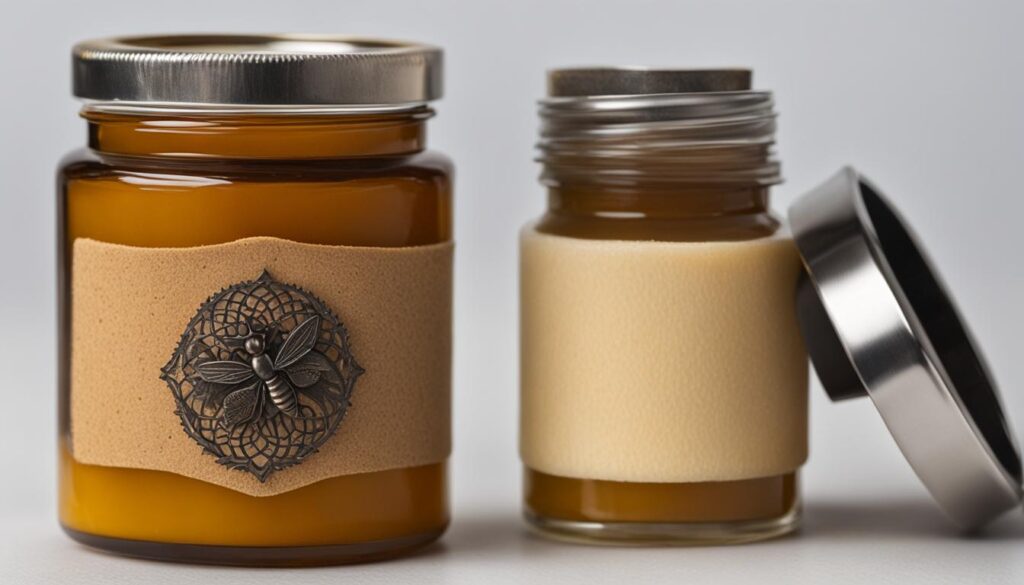
Benefits of Beeswax
Beeswax is a versatile natural ingredient that offers a multitude of benefits across various industries. Let’s explore some of the key advantages and uses of beeswax.
Beeswax has a wide range of benefits and uses. It is commonly used in natural skincare products as it helps moisturize and soothe the skin. Beeswax is also used in candle making due to its clean-burning properties. It has antimicrobial and anti-inflammatory properties, making it beneficial for wound healing and soothing skin irritations. Beeswax can also be used in various crafts and DIY projects.
In the realm of skincare, beeswax acts as a natural emollient, sealing in moisture and creating a protective barrier on the skin. This makes it an excellent ingredient for lip balms, lotions, and creams. Its anti-inflammatory properties can help reduce redness and irritation, making it suitable for sensitive or irritated skin.
When it comes to candles, beeswax is a popular choice due to its clean and long-lasting burn. Unlike paraffin-based candles, beeswax candles produce minimal soot and do not release harmful toxins when burned. They also emit a subtle honey-like scent, creating a soothing and inviting ambiance.
Furthermore, beeswax has been used for centuries in traditional medicine for its healing properties. Its antimicrobial abilities can help protect wounds from infection, while its anti-inflammatory nature aids in reducing inflammation and promoting faster healing. Many natural remedies and ointments for minor cuts, burns, and skin conditions include beeswax as a key ingredient.
Aside from skincare and candles, beeswax can be utilized for various crafting and DIY projects. It can be used in making natural beeswax wraps as a sustainable alternative to plastic wrap, creating homemade furniture polish to nourish and protect wood surfaces, and even in sculpting or modeling as a malleable and non-toxic material.
Conclusion
Beeswax offers a range of benefits and uses that make it a valuable natural resource. From skincare and candles to wound healing and crafts, its versatility and properties make it a sought-after ingredient. Incorporating beeswax into your daily life not only brings the satisfaction of using natural and sustainable products but also allows you to experience the many benefits it has to offer.
Sustainable Harvesting of Beeswax
Harvesting beeswax is not only a valuable process but also one that should be done sustainably to protect bee populations and promote responsible beekeeping practices. By adopting sustainable methods, we can ensure the long-term viability of both bees and the environment they thrive in.
One of the key aspects of sustainable beeswax harvesting is only taking excess wax from the hive. Bees rely on their wax to create a stable structure for their colonies and store honey. By leaving enough wax for the bees to maintain their hive, we allow them to continue their essential activities without disruption.
To protect bee populations, it is crucial to practice responsible beekeeping. This involves providing bees with a healthy environment free from harmful chemicals and pesticides. Responsible beekeepers also prioritize the well-being of their bees by regularly monitoring and managing their hives, ensuring they have access to a diverse range of forage, and taking measures to mitigate the impact of diseases and pests.
By promoting sustainable beeswax harvesting and responsible beekeeping practices, we can contribute to the preservation of bee populations and the overall health of our ecosystems. Bees play a vital role in pollination, which is essential for the reproduction of many plants and crops. In turn, this benefits biodiversity, food production, and the overall stability of our environment.
Protecting Bee Populations: A Collective Responsibility
In conclusion, sustainable beeswax harvesting is not just a responsibility for individual beekeepers but a collective effort. By adopting sustainable practices and protecting bee populations, we can ensure the continued availability of this precious natural resource and contribute to a healthier and more sustainable future for both bees and humans alike.
| Sustainable Beeswax Harvesting | |
|---|---|
| Benefits |
|
| Responsible Beekeeping Practices |
|
Conclusion
In conclusion, beeswax harvesting is a valuable process that requires careful extraction, filtering, and cleaning. This natural resource offers numerous uses and benefits, making it highly sought after in various industries. However, it is crucial to prioritize sustainable practices to protect bee populations and preserve the environment.
By following responsible beekeeping practices, such as leaving enough beeswax for the bees to maintain their hive and avoiding the use of harmful chemicals, we can contribute to sustainable beeswax harvesting. This ensures the continued availability of this valuable resource for future generations.
Whether it’s in natural skincare products, candles, or wound healing, beeswax has proven to be a versatile and beneficial substance. Additionally, utilizing beeswax responsibly allows us to enjoy its benefits while supporting the well-being of bees and the overall ecosystem.
FAQ
When is the best time to harvest beeswax?
Beeswax is best harvested when there are fewer bees around the hive, typically in the morning or late afternoon.
What protective gear should I wear for beeswax harvesting?
It is important to wear a beekeeper’s suit, including a veil, suit, and gloves, to minimize the risk of bee stings.
What tools and equipment do I need for beeswax harvesting?
You will need a beekeeper’s outfit, bee smoker, hive tool, bee brush, hot uncapping knife, and a bucket.
How do I remove beeswax from frames?
Using a hot uncapping knife, you can scrape off the wax caps from frames and collect them in a bucket.
How do I filter and clean beeswax?
Wrap the wax caps in cheesecloth and place them in a pot of water. Heating the water will melt the beeswax, and squeezing the cheesecloth will extract more wax.
How should I store beeswax?
Beeswax should be stored in a cool and dry place, preferably in airtight containers to maintain its quality.
What are the benefits of beeswax?
Beeswax has moisturizing and soothing properties, making it beneficial for skincare products. It is also used in candle making and has antimicrobial and anti-inflammatory properties for wound healing.
How can I harvest beeswax sustainably?
To harvest beeswax sustainably, only harvest excess wax and leave enough for the bees to maintain their hive. Practice responsible beekeeping and avoid harmful chemicals.

